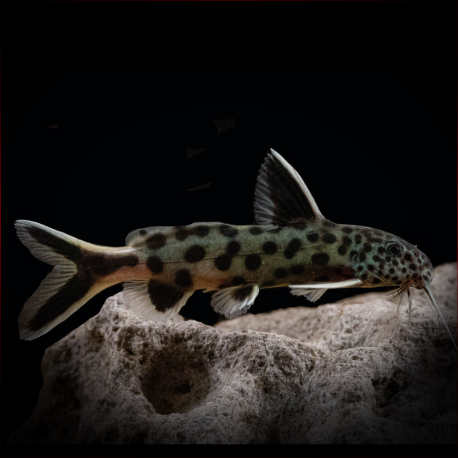More info
Datasheet
| Minimum Tank Size | 120 litres / 31.70 US gallons |
| Maximum Size | 10.2cm / 4.02inches |
| Temperament | Peaceful |
| Care Description | Moderate |
| Temperature | 22.2°C / 71.96°F - 25.6°C / 78.08°F |
| Carbonate Hardness | 4-12 |
| pH | 6.5-8.0 |
General Description
The Dwarf Petricola Synodontis Catfish, also referred to as the False Cuckoo Catfish or Synodontis lucipinnis, is a peaceful African Catfish native to Lake Tanganyika. Boasting a diminutive size of up to 10.2cm, this species features a creamy-gold body adorned with dark polka dots having muted edges, along with dark fins accented by white edges.
Aquarium Setup
To recreate its natural habitat, provide the Dwarf Petricola Synodontis Catfish with a tank of at least 120 litres containing a fine sandy substrate and ample large roots and crevices for hiding. Water parameters should ideally range from a pH of 6.5-8.0, a KH of 4-12, and a temperature between 22.2-25.6°C (see table).
Behaviour
Known for its peaceful temperament, this Catfish species is a suitable addition to community tanks. It exhibits amicable behavior, making it an excellent option for novice hobbyists as it can withstand less than ideal water conditions compared to other Synodontis species.
Feeding and Diet
As an omnivore, the Dwarf Petricola Synodontis Catfish should be fed a varied diet including sinking catfish pellets, frozen/thawed bloodworms, brine shrimp, mysis shrimp, and high-quality flake food. Offering a diverse diet will help ensure the catfish receives essential nutrients for optimal health.
Reproduction & Dimorphism
Information regarding the specific reproductive behavior and dimorphic characteristics of the Dwarf Petricola Synodontis Catfish is not provided in the available data.
Habitat and Distribution
Endemic to Lake Tanganyika in Africa, the Dwarf Petricola Synodontis Catfish inhabits freshwater environments with sandy bottoms and abundant roots for shelter. Its natural habitat influences the aquarium setup required for this species to thrive successfully within a captive environment.

